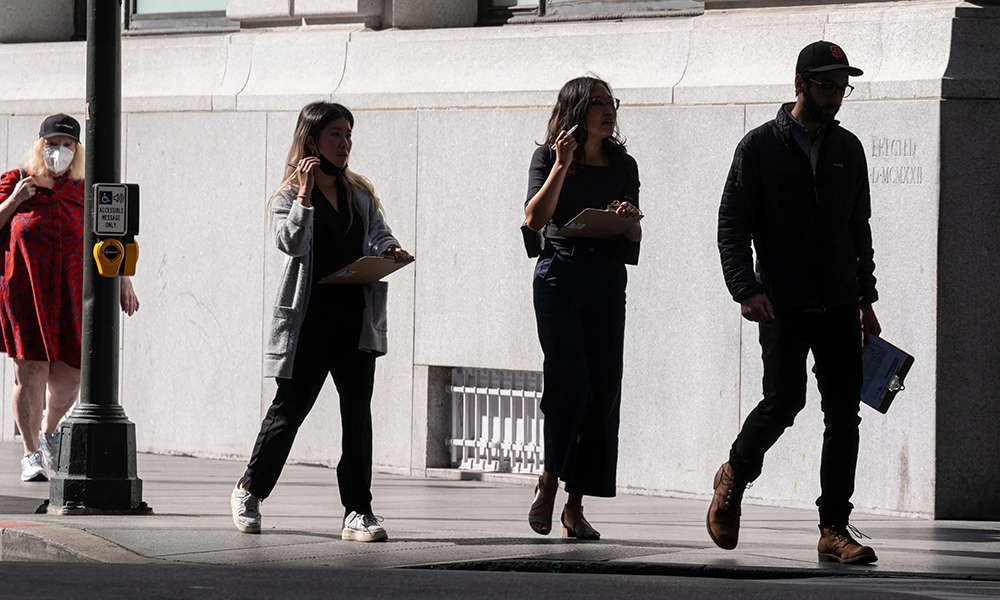大批辞职者感到后悔,并不意味着雇主可以摆脱人才困境

最近的调查发现,一些在大辞职浪潮期间辞职的上班族终于感到后悔,因此人们讨论的话题迅速从公司如何留住员工,变成将员工大量辞职归咎为冲动之举。
然而,一些最重要的发现却被忽视。在一项调查中,超过三分之一受访者表现出“买家后悔”的情绪,但他们同时感觉工作生活平衡下降(36%),约三分之一(30%)受访者表示,他们的新工作与自己的预期存在差异,四分之一(24%)受访者表示怀念上一份工作的职场文化。
我们关注的焦点不应该是在大辞职浪潮期间辞职的人们开始后悔这个事实,而是应该思考导致员工辞职的因素,人们即使换工作也无法避开这些因素。
调查发现,不良职场文化是可预测员工流失的头号因素。员工因为不良职场文化离职的可能性,比因为低薪酬离职的可能性高10.4倍。可悲的是,有许多员工在职场中遭受了敌意、歧视和霸凌,而付出最高代价的几乎都是女性和有色人种女性。
这些调查结果与LHH的第一期就绪指数(Readiness Index)一致。该指数正在进行为期三年的行为学研究,旨在评估人们针对下一次职业变动的准备就绪情况。我们重点研究了美国、英国和法国的金融服务业员工,使用一系列隐性问答测试和显性调查问卷,以更好地了解人们所说的话与他们对工作、职业和未来的真实感受之间的差异。
从个人、工作场所和环境因素(如焦虑感、不同的公司文化和自动化水平提高的影响等)综合考虑,该指数可以确定人们影响其就绪水平的有意识和无意识态度,并衡量了各国之间的差异。该指数发现,所有相关国家都有较高的平均就绪评分,其中美国上班族的就绪评分排在首位,高达8分(总分10分),这意味着他们对职业变化已经做好了非常充足的准备。
要解决不良职场文化,在某种程度上意味着了解人们的这种不良感受来自哪些方面。我们有一个惊人的发现,男性更有可能感觉职场文化是不良的,比女性高29%。这并不意味着他们受到更大影响,但这种观点可能引发员工不满,因此公司必须从影响和动机方面出发采取干预措施,解决人们所感受到的真实存在的不良文化。
促使人们寻找新工作机会的另外一个关键因素是薪酬问题。薪酬正在飞速上涨,2021年跳槽者的收入增加了5.4%,而留在原公司的上班族收入增加了3.5%。然而,对于大多数上班族而言,工资上涨赶不上通胀的上涨速度,而且随着通货膨胀持续导致成本增加,雇主开始缩减预算,薪酬上涨的趋势可能结束,这只会进一步提高职场文化对员工和求职者的重要性。
我们还发现人们对身心健康的投入大幅增加,效果各不相同。这一点值得关注。我们发现,34%的Z世代与同事格格不入,而女性对长期职业发展赶到焦虑的概率高16%。我们的研究显示,美国女性不认为他们能获得与男性同样多的发展机会。科技也在加剧焦虑,有36%的受访者属于技术恐惧者。
免费远程治疗、不开会的星期五、健身房会员和冥想等福利,几乎变成了公司的标准福利。这些福利当然有一定的价值,但对于大多数员工而言还远远不够。他们认为这些福利并没有解决导致他们压力上升的核心问题,因此有38%经历了职场倦怠的受访者没有得到任何缓解。
LHH的就绪指数发现,33%的18至24岁上班族在工作中感觉自己的意见被忽视,有30%的女性感觉在工作中遭到排挤。其他研究发现,少数群体和女性对灵活办公时间的感受最强烈,而且他们能够最敏感地感觉到灵活办公可以让他们暂时避开办公室政治、轻度冒犯和歧视。
如果“大后悔潮”让雇主以为我们将恢复现状,他们可能会失算。不良职场文化正在加剧美国上班族持续面临的精神健康危机。无法解决这个问题的公司,将成为人才争夺战中的失败者。(财富中文网)
本文作者盖利·德拉福瑟现任LHH总裁。
Fortune.com上发表的评论文章中表达的观点,仅代表作者本人的观点,不能代表《财富》杂志的观点和信仰。
翻译:刘进龙
审校:汪皓
最近的调查发现,一些在大辞职浪潮期间辞职的上班族终于感到后悔,因此人们讨论的话题迅速从公司如何留住员工,变成将员工大量辞职归咎为冲动之举。
然而,一些最重要的发现却被忽视。在一项调查中,超过三分之一受访者表现出“买家后悔”的情绪,但他们同时感觉工作生活平衡下降(36%),约三分之一(30%)受访者表示,他们的新工作与自己的预期存在差异,四分之一(24%)受访者表示怀念上一份工作的职场文化。
我们关注的焦点不应该是在大辞职浪潮期间辞职的人们开始后悔这个事实,而是应该思考导致员工辞职的因素,人们即使换工作也无法避开这些因素。
调查发现,不良职场文化是可预测员工流失的头号因素。员工因为不良职场文化离职的可能性,比因为低薪酬离职的可能性高10.4倍。可悲的是,有许多员工在职场中遭受了敌意、歧视和霸凌,而付出最高代价的几乎都是女性和有色人种女性。
这些调查结果与LHH的第一期就绪指数(Readiness Index)一致。该指数正在进行为期三年的行为学研究,旨在评估人们针对下一次职业变动的准备就绪情况。我们重点研究了美国、英国和法国的金融服务业员工,使用一系列隐性问答测试和显性调查问卷,以更好地了解人们所说的话与他们对工作、职业和未来的真实感受之间的差异。
从个人、工作场所和环境因素(如焦虑感、不同的公司文化和自动化水平提高的影响等)综合考虑,该指数可以确定人们影响其就绪水平的有意识和无意识态度,并衡量了各国之间的差异。该指数发现,所有相关国家都有较高的平均就绪评分,其中美国上班族的就绪评分排在首位,高达8分(总分10分),这意味着他们对职业变化已经做好了非常充足的准备。
要解决不良职场文化,在某种程度上意味着了解人们的这种不良感受来自哪些方面。我们有一个惊人的发现,男性更有可能感觉职场文化是不良的,比女性高29%。这并不意味着他们受到更大影响,但这种观点可能引发员工不满,因此公司必须从影响和动机方面出发采取干预措施,解决人们所感受到的真实存在的不良文化。
促使人们寻找新工作机会的另外一个关键因素是薪酬问题。薪酬正在飞速上涨,2021年跳槽者的收入增加了5.4%,而留在原公司的上班族收入增加了3.5%。然而,对于大多数上班族而言,工资上涨赶不上通胀的上涨速度,而且随着通货膨胀持续导致成本增加,雇主开始缩减预算,薪酬上涨的趋势可能结束,这只会进一步提高职场文化对员工和求职者的重要性。
我们还发现人们对身心健康的投入大幅增加,效果各不相同。这一点值得关注。我们发现,34%的Z世代与同事格格不入,而女性对长期职业发展赶到焦虑的概率高16%。我们的研究显示,美国女性不认为他们能获得与男性同样多的发展机会。科技也在加剧焦虑,有36%的受访者属于技术恐惧者。
免费远程治疗、不开会的星期五、健身房会员和冥想等福利,几乎变成了公司的标准福利。这些福利当然有一定的价值,但对于大多数员工而言还远远不够。他们认为这些福利并没有解决导致他们压力上升的核心问题,因此有38%经历了职场倦怠的受访者没有得到任何缓解。
LHH的就绪指数发现,33%的18至24岁上班族在工作中感觉自己的意见被忽视,有30%的女性感觉在工作中遭到排挤。其他研究发现,少数群体和女性对灵活办公时间的感受最强烈,而且他们能够最敏感地感觉到灵活办公可以让他们暂时避开办公室政治、轻度冒犯和歧视。
如果“大后悔潮”让雇主以为我们将恢复现状,他们可能会失算。不良职场文化正在加剧美国上班族持续面临的精神健康危机。无法解决这个问题的公司,将成为人才争夺战中的失败者。(财富中文网)
本文作者盖利·德拉福瑟现任LHH总裁。
Fortune.com上发表的评论文章中表达的观点,仅代表作者本人的观点,不能代表《财富》杂志的观点和信仰。
翻译:刘进龙
审校:汪皓
When recent surveys revealed that some workers who left their jobs during the Great Resignation ultimately regretted quitting, the narrative quickly shifted from how organizations should address retention to chalking this worker exodus up to an ill-planned whim.
However, some of the most significant findings were overlooked. In one survey, more than a third of respondents who expressed buyer’s remorse also felt work-life balance had declined (36%), about a third (30%) said their new job was different than what they were led to expect, and one in four (24%) said they miss the culture of their old job.
Rather than fixating on the fact that some Great Resigners are having second thoughts, we should focus on the factors that drove workers out in the first place–and that they weren’t able to escape even in their next job.
Toxic work culture was found to be the number one predictor of attrition. It’s 10.4 times more likely than low compensation to contribute to employee turnover. Sadly, stories of employees experiencing hostility, discrimination, and bullying are in abundant supply, and overwhelmingly it’s women and women of color paying the highest price.
These findings align with the first installment of LHH’s Readiness Index, an ongoing three-year behavioral science study that measures how ready people are for their next career move. We focused on financial service employees across the U.S., U.K., and France, using a series of implicit response tests and explicit questionnaires to better understand the gap between what people said and what they really felt about work, their careers, and their futures in general.
Looking at a combination of personal, workplace, and environmental factors (such as feelings of anxiety, differing company cultures, and the impact of the rise in automation), the index was able to determine people’s conscious and unconscious attitudes that impacted readiness while also measuring differences from country to country. What it found was that the average Readiness Score was in fact high across all the countries involved–with U.S. workers coming in the strongest with a score of eight out of 10, indicating an extremely high degree of readiness when it comes to making career changes.
Part of addressing toxic workplace culture means understanding where perceptions of toxicity are and aren’t coming from. We uncovered a surprising finding: Men, not women, are more likely to feel their workplace is toxic by 29%. That’s not to say they’re suffering more greatly, but that view alone could be stirring up discontent and interventions must account for both impact and intention to address real and perceived toxicity.
Pay, another key driver of people seeking new opportunities, saw record-breaking increases, with job switchers earning 5.4% more in 2021, and those who stayed with their company earning 3.5% more. However, these hikes have been outpaced by inflation for most workers–and as inflation continues to drive up costs and employers tighten their belts, this surge in compensation is likely to come to an end, which will only drive workplace culture further to the forefront for employees and job seekers alike.
We’ve also seen a tremendous increase in well-being investment, to varying degrees of success. And the attention is warranted. We found that 34% of Gen Zers don’t get along with colleagues and that women are 16% more likely to be anxious about their careers long-term–with our study suggesting U.S. women don’t believe they have as many opportunities to grow. Tech is also driving anxiety, with 36% of people falling into the category of technophobes.
Free teletherapy, meeting-free Fridays, gym memberships, and meditation offerings have become nearly standard benefits fare. While valuable, these perks don’t go far enough for most employees, who feel this isn’t getting at the heart of what’s actually causing such high rates stress, leaving the 38% of people who experience workplace burnout with little reprieve.
LHH’s Readiness Index found that 33% of workers who are 18-24 don’t feel heard at work, and that 30% of women feel excluded at work. Other studies have found that underrepresented groups and women feel strongest about maintaining flexible work schedules, and who most acutely felt the reprieve from office politics, microaggression, and discrimination.
If the idea of the "Great Regret" made employers think we'll return to the status quo, we won't. Workplace toxicity is fueling the mental health crisis American workers continue to face. The losers of the talent war will be those who fail to address it.
Gaëlle de la Fosse is the president of LHH.
The opinions expressed in Fortune.com commentary pieces are solely the views of their authors and do not reflect the opinions and beliefs of Fortune.













